Let’s Make Low FODMAP Kimchi
Low FODMAP Kimchi can be made at home, with our step-by-step instructions – and please pay attention to our caveats – and the question mark! More on that down below.
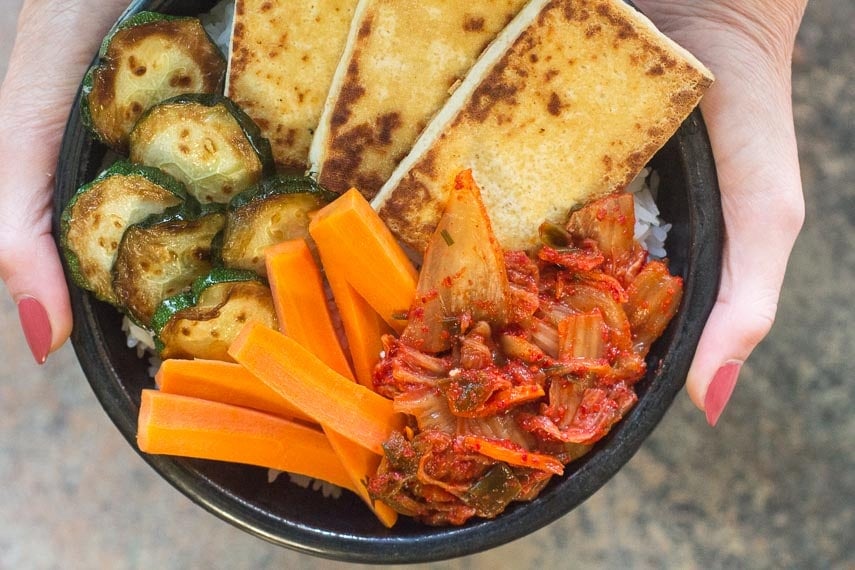
Monash University has not lab tested kimchi, but it has tested pasteurized fermented white cabbage and pasteurized fermented red cabbage.
For more complete info on Cabbage in general, please see our Explore An Ingredient: Cabbage article.
Also, to truly understand if kimchi is low FODMAP, our article, Is Kimchi Low FODMAP? is required reading as a companion to this recipe.
First, What Is Kimchi?
Kimchi is a traditional Korean fermented cabbage dish. It comes in many different variations, of which this is a fairly basic rendition.
Napa cabbage is very low FODMAP – you can eat over 6 cups (500 g) before it becomes Moderate for FODMAPs.
For kimchi, Napa cabbage is typically used. It is salted, then seasoned with a spicy, vibrantly colored paste made from chiles, ginger and usually lots of onion and garlic (more on that in a moment).
The mixture is allowed to ferment at room temperature for days, weeks or months to allow and encourage fermentation before being refrigerated and/or pasteurized.
For some, kimchi is an acquired taste. But if you like fermented foods and fish sauce is a pantry staple, then you are going to love our version of kimchi. It is packed with umami!
How To Lab Test Kimchi
Again, please read our companion article, Is Kimchi Low FODMAP?, to fully understand what we are discussing here.
If Monash did test kimchi I would want to know the following:
-
- What kind of cabbage was used in the product tested?
- Did the product/recipe contain garlic and/or onions?
- Was the product pasteurized or unpasteurized?
- If the product was raw and unpasteurized, was it tested at various stages of fermentation, since it is a live product?
- Since the fermented cabbage products that they have already tested were pasteurized, do we know at what point of fermentation the products reached before they were pasteurized?
- Can Monash go back and also test raw fermented red cabbage and sauerkraut to compare with the already tested pasteurized products?
UPDATE: Monash lab tested kimchi in early 2020.
Monash says that it is “Korean style”, which we believe means that it is a live, fermented, unpasteurized product. They mention that it contains cabbage and radish. After that, we have no further information, such as whether it contains onions and/or garlic. A low FODMAP amount is 47 g and it becomes Moderate for mannitol in particular at 70 g and high FODMAP at 75 g (which they helpfully state is ½ cup).
Some of our questions above still stand, but at least now we know that we are in the ballpark in terms of feeling bold enough to sample traditionally fermented kimchi even during Elimination.
 Why All The Questions About Pasteurization?
Why All The Questions About Pasteurization?
In terms of food preservation, pasteurization is the process of exposing food to a high heat temperature in order to kill off any bacteria that might prevent the food from safe storage. Listeria, for instance, would be killed during a proper pasteurization process.
The problem with killing off bacteria is that we often look to fermented foods for their live, active bacterial content. AND, the most important part of this from a FODMAP perspective, is that pasteurization kills bacteria that are part of the fermentation process. The fermentation effectively halts at pasteurization.
We know from talking with fermentation specialists, such as Dan Rosenberg at Real Pickles and Mark Phillips at Hosta Hill, that a longer fermentation time will possibly create a more low FODMAP product. (If you want to experience some fantastic prepared fermented products that are live and packed with probiotics and happen to live in the northeast USA, give these two companies a try).
Unless we know that a pasteurized product was allowed to fully ferment before being pasteurized, residual mannitol could be present.
The fact that mannitol showed up in the Monash lab tests makes me think that perhaps the sauerkraut was not fully fermented when pasteurized.
The QUESTION Mark!?
I do not know if anyone will ever lab test kimchi, and even if they do, whatever they test, the results would not necessarily be comparable to a homemade product – or any other batch of raw kimchi, for that matter, since it is a live product.
THAT’S WHY I have put a question mark next to our title. We do NOT know if this kimchi is low FODMAP, but we can make some extrapolations and educated guesses and we can make recommendations for serving size and an approach for sampling.
About Onion & Garlic & FODMAPs
We have to talk about onions and garlic when it comes to kimchi, and as you hopefully know by now, onions and garlic contain water-soluble fructans, which is a FODMAP category that can trigger IBS symptoms in many people.
These fructans, being water-soluble, cannot be used in a traditional kimchi preparation for us FODMAPers; cabbage has a very high water content, for instance. If garlic and onion were to be added to and combined with the cabbage, other vegetables and the chile paste, the fructans would leach into the kimchi mixture, creating a high FODMAP situation.
(Remember, fructans are not oil-soluble, which is why we can make Garlic-Infused Oil).
So, how are we going to get onion and garlic flavor into our kimchi?
I had considered adding asafetida, which is an Indian spice that has garlicky flavor, but that would have been quite untraditional. Not that there is anything inherently wrong with that, but I first wanted to try a fairly classic approach.
This meant using all of the oniony, garlicky low FODMAP tools at our disposal. So, you will find scallion greens and garlic chives, or regular chives, in generous quantity in our kimchi.
If you are a classicist, you might find our kimchi to have a different flavor profile than you are used to, or were expecting, but we are simply thrilled that we can enjoy kimchi and have it be potentially low FODMAP.
So, How Much FODMAP Everyday® Kimchi Can I Eat?
You can eat as much kimchi as you can personally tolerate. You will notice that we have not given this recipe a “green kiwi” icon status of being Elimination friendly, as we simply do not know its FODMAP content.
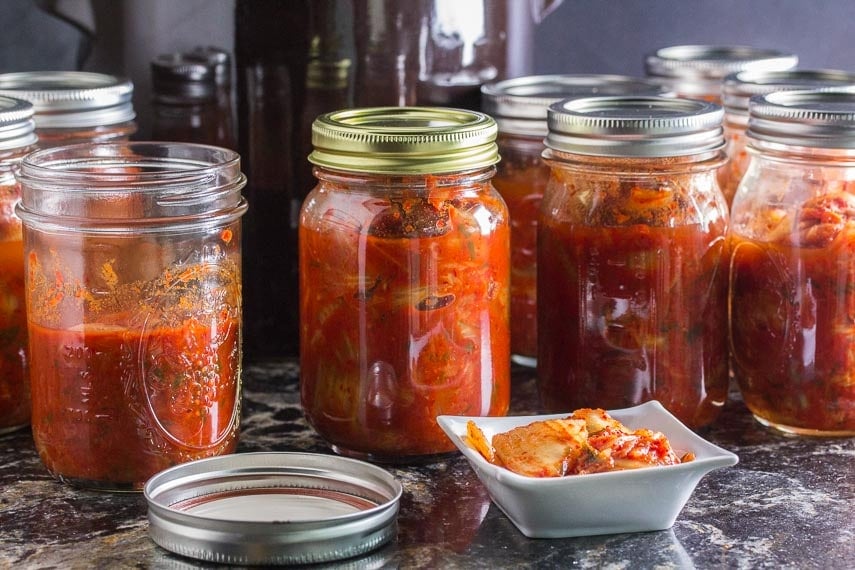
Here are our extrapolations and serving size recommendations:
-
- Napa cabbage, which is used in this recipe, has a very large amount of wiggle room between its low FODMAP status and moderate status, allowing generous low FODMAP serving sizes when raw.
- Napa cabbage contains fructans, which is the same FODMAP in red cabbage and NOT the same as green cabbage, which has shown sorbitol, in some tests.
- Fermented red cabbage is low FODMAP in much larger portions than fermented green cabbage – almost 8 times larger.
- We are making an educated guess that Napa cabbage, when fermented in a kimchi preparation, will act more similarly to red cabbage, due to its FODMAP content when raw.
- We now know that the sauerkraut that Monash tested was pasteurized and the mannitol they found might be a result of the product not being fully fermented at the time of pasteurization.
- Our kimchi is a raw product and allowed to fully ferment.
- We are suggesting that you begin with a very conservative serving size of 1 tablespoon of our kimchi and increase from there. Many of you will be able to eat much more, but you can only assess your tolerance through actual incremental testing.
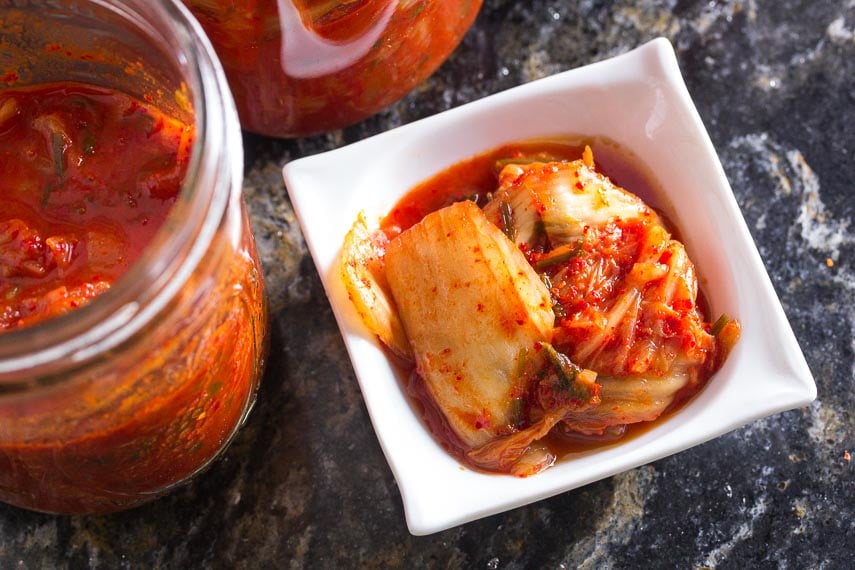
Also, please review our articles, Explore An Ingredient: Cabbage; What Is A Low FODMAP Serving Size? and What If A Food Has Not Been Lab Tested for FODMAPs?
PS: You are going to need large, non-reactive bowls or pots to handle the large quantity of cabbage, so get ready! I use very large mixing bowls and also large stockpots to get the job done.
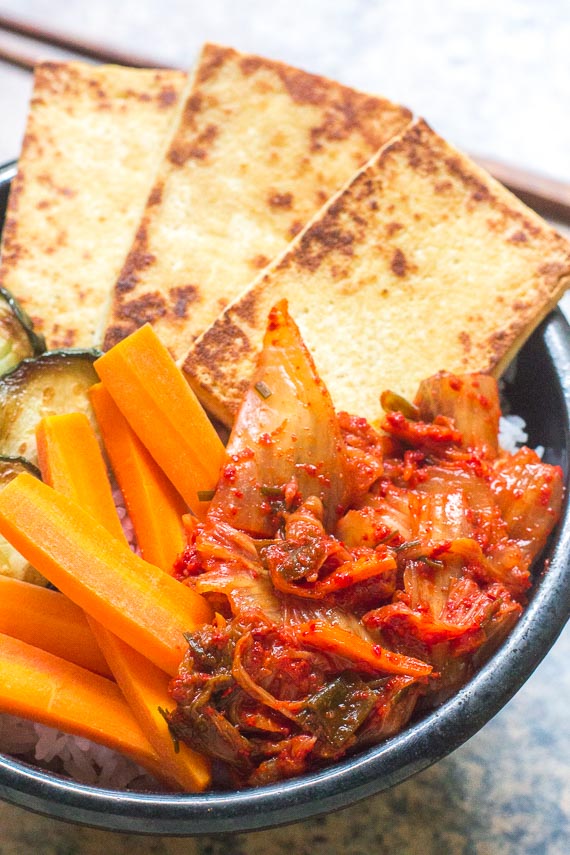
For an easy and quick pickle, check out our Low FODMAP Japanese Pickles.
For a recipe using our kimchi, check out our hearty, spicy tofu stew.
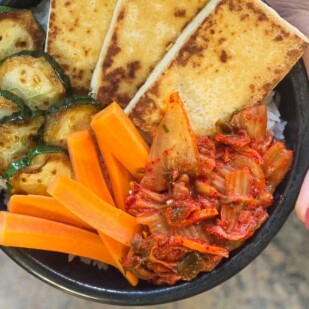
Low FODMAP Kimchi ?
Looking for low FODMAP kimchi? Try our recipe!
Low FODMAP Serving Size Info: Makes about 14 cups (3.5 kg); 224 servings; 1 serving = 1 tablespoon (16 g).
Ingredients:
Cabbage:
- 6- pounds (2.7 kg) Napa cabbage, quartered lengthwise, cored and chopped into large bite-size pieces
- ½ cup (90 g) kosher salt
Porridge:
- 2 cups (480 ml) water
- 2 tablespoons sweet rice flour
- 2 tablespoons Turbinado sugar, or white or brown sugar
Vegetables:
- 8- ounces trimmed and peeled daikon, julienned to yield 2 cups
- 4- ounces trimmed and peeled carrot, julienned to yield 1 cup
- 1 ½ ounces (40 g) chopped chives, or garlic chives if you tolerate them
- 3- ounces (85 g) finely chopped scallions, green parts only, to yield 2 cups
Spice Mixture:
- 2 cups (240 g) hot red pepper flakes (gochugaru)
- ½ cup (120 ml fish sauce, such as Red Boat
- 2 teaspoons minced fresh ginger root
Preparation:
-
Begin with Salting the Cabbage: Place the cabbage in a large non-reactive bowl or container and add the salt as you go so that the cabbage and salt are added in layers. Toss very well to evenly distribute the salt. Allow to sit for 30 minutes, then stir it all together very well to re-distribute any salt and exuded liquid. Allow to sit for another 30 minutes and repeat the mixing process. Let it sit for 30 more minutes and stir again.
-
Meanwhile, Make the Porridge: Whisk together the water and rice flour in a small saucepan and bring to a simmer over medium heat, whisking frequently. Simmer for about 5 minutes or until it begins to thicken. Whisk in sugar and continue to cook for several more minutes, whisking often, until mixture is thickened and a bit glossy. Cool completely.
-
For the Vegetables & Spice Mixture: Place all of the vegetables in a large mixing bowl that is large enough to hold all of your ingredients and toss them together. Add the spice mixture (the gochugaru, fish sauce and ginger root) and the cooled porridge and stir everything together. It will be the texture of a thick paste.
-
Back To The Cabbage: Drain the salted cabbage (you might have to do this in batches), discarding any liquid. Soak the salted cabbage in clean water and then drain, three separate times. Taste the cabbage. It should taste just faintly salty.
-
Add the cabbage to the large bowl with the vegetable/spice mixture. Combine everything very well. I usually put on rubber gloves and get in there with my hands. The cabbage should be completely coated with the spice mixture.
-
Pack the kimchi into a large non-reactive container with an airtight cover. (I use a ceramic pot made for fermenting and pickling vegetables). Set aside at room temperature for at least 4 days.
-
Here is where the art of kimchi making comes in. So far, everything has just been straightforward preparation of combining particular amounts of ingredients in a specific way. Now the magic (and scienchappens!
-
The bacteria that is present will go to work, and depending on your ambient temperature, it could take days, or weeks, for your kimchi to be “done”.
-
At first the naturally occurring lactobacillus breaks down the structure of the vegetables. The mixture produces acids and gases and it might taste sour, smell very strong and pungent and possibly not very enticing at this stage. Then as fermentation continues, the kimchi begins to mellow.
-
Many manufacturers look for the acidity to rise and for the pH to be below 4.6% as one marker for safety. I purchased pH strips to test my kimchi and most batches reached this level between 5 and 8 days.
-
Technically speaking, fermentation is completed when the sugars in the vegetables have been consumed, but as my consulted experts have explained, practically speaking, you’d never really ferment to the point of having zero residual sugar.
-
Because CO2 and bubbling is produced during fermentation, you might want to “burp” your container after a few days to allow excess gas to escape. If it cannot escape, the kimchi can become fizzy and carbonated, which is undesirable.
-
There might be quite active bubbling and CO2 production during fermentation, and this will largely cease when fermentation is “done”, however, some milder bubbling action might continue after you have stopped your fermentation stage and begun to refrigerate your kimchi.
-
So how do you tell when your kimchi is done? Look for the markers mentioned above, and taste it! It should taste pleasantly sour. If your batch is putrid, you will know it, in which case discard it. Some manufacturers ferment for 6 months or more!
-
Pack your kimchi into smaller containers, leaving a bit of room at the top and refrigerate for up to several months – some say years!
Notes:
Tips
- By biggest tip is, Don’t Be Afraid To Try This! It seems daunting, but I promise that if you take your time and follow my instructions, that you will be able to make low FODMAP kimchi!
Nutrition
All nutritional information is based on third-party calculations and should be considered estimates. Actual nutritional content will vary with brands used, measuring methods, portion sizes and more. For a more detailed explanation, please read our article Understanding The Nutrition Panel Within Our Recipes.

Low FODMAP Recipes Created Just For You!
We take low FODMAP recipes seriously at FODMAP Everyday®. That’s why Dédé oversees our Test Kitchen and makes sure that each and every recipe works – and is low FODMAP following the most up-to-date science.
Read our article How Are Low FODMAP Recipes Created? for more in-depth information.
Rest assured that you will not find more trustworthy or delicious low FODMAP recipes anywhere – several hundred and counting.
FODMAP Everyday®Low FODMAP Recipes At A Glance:
- FODMAP Everyday®is accredited by FODMAP Friendly.
- Dédé is low FODMAP trained by Monash University.
- Dédé is also individual accredited as a recipe developer and FODMAP educator by FODMAP Friendly.
- We maintain our own professional Test Kitchen.
- Dédé has over 30 years of professional recipe development experience, including her stint as a Contributing Editor for Bon Appetit magazine and has written 17 cookbooks.
Come Join Our Low FODMAP Recipe Community!
Use Our Exclusive Recipe Filter To Find The Low FODMAP Recipe You Are Looking For Today!
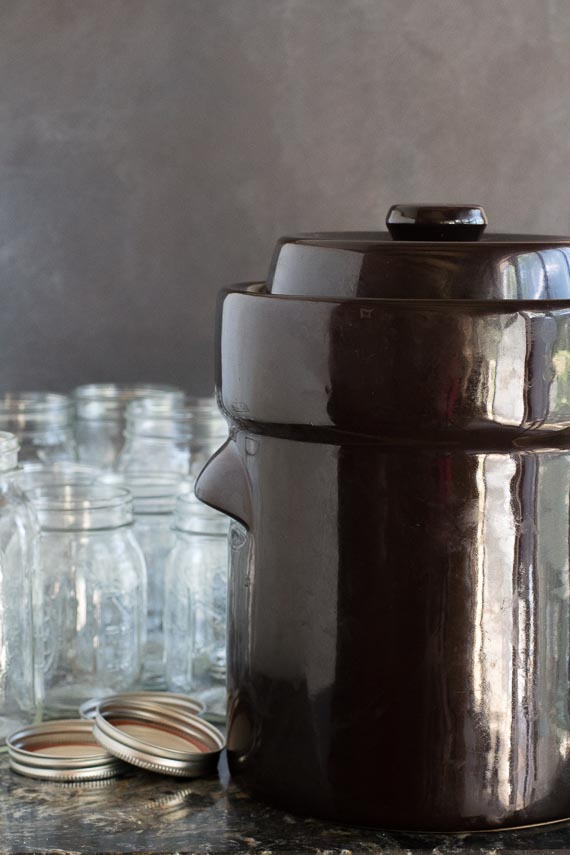
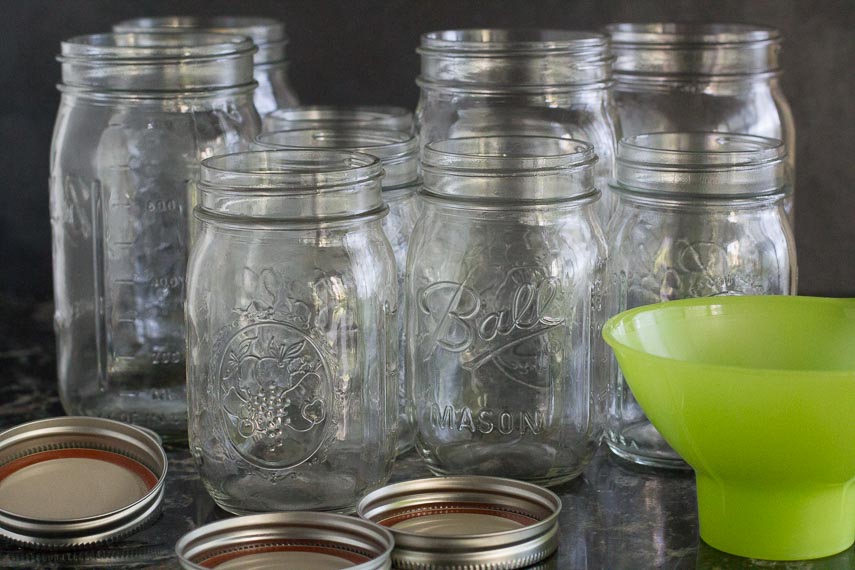 Why All The Questions About Pasteurization?
Why All The Questions About Pasteurization?
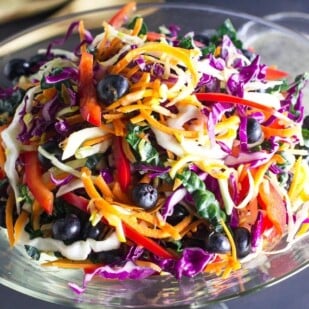




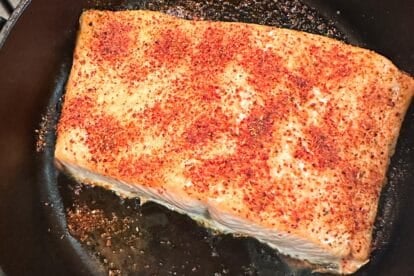
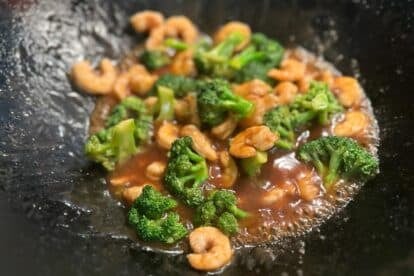
This recipe is for a large batch of kimchi. Since I want to make a much smaller batch to see if I can tolerate it, and have no experience with fermentation, my question is, does the fermentation process act the same with smaller batches?
You could try with a smaller batch. But consider this…it will basically be the same amount of work and waiting time, so why not make the whole batch and if you do not do well with it, you will have awesome edible gifts to give away!
Latest and greatest on the Monash University app: they have apparently tested kimchi, and it meets guidelines for low and moderate quantity servings! If someone is just starting elimination, they should start with the smallest portion, at 47g (per the app). That’s about the equivalent of 2 tbs for US audience. But hey! Banchan! 😃
Yes we have addressed this at length in our other kimchi article. I have had discussion with Monash about what kind of kimchi was tested, was it live or pasteurized, at what point in fermentation was it tested etc…and there are not a lot of clear answers.
Can you replace the spring onion with wild garlic?le
From a taste perspective it would be an interesting substitution. We cannot comment on the FODMAP load. If you mean garlic “greens”, then you might give it a try when you are stable and in your Challenge Phase. If you mean wild garlic itself, the FODMAP load would undoubtably increase.
I am not sure at what point to add the fish sauce
It is step 3 where is says Spice Mixture, which is the gochugaru, fish sauce and ginger root. I just added parenthetical info to make it clearer.
You mentioned the need for longer fermentation to break down mannitol.
This recipe has a fairly normal fermentation time. Is that long enough? Should I let it go longer to be sure? I’ve done regular kraut for several month long fermentation, but I’ve never tried that long for Kimchi.
You could certainly play with the fermentation time, but we won’t know the results w/o lab testing, and of course we do not have access to that. Also, please read the accompanying article on kimchi, Monash testing and “what” they tested.
This is AMAZING. I thought I could never eat kim chi again! I cut the spice into 1/4 of the amount bc I’m a wimp. This is the best I’ve tasted outside of a Korean restaurant. Thank you!!
OH JENNIE this made our week! Thank you so much for letting us know. We are thrilled to be part of your low FODMAP journey.